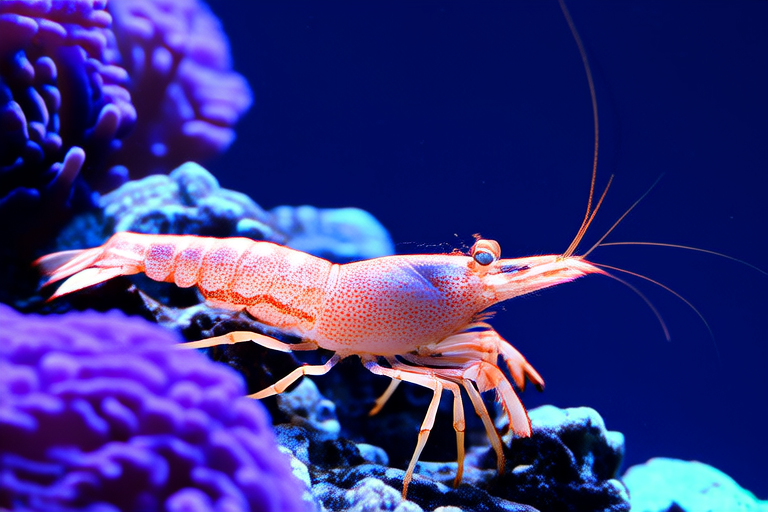Everything You Need to Know Before Adding Coral Shrimp to Your Aquarium
Coral shrimp, also known as Stenopus hispidus, are popular additions to saltwater aquariums due to their striking appearance and interesting behaviors. These small crustaceans, native to tropical and subtropical waters, can bring a vibrant splash of color to your tank while also providing some beneficial cleaning services. However, before you decide to add them to your aquarium, there are several important factors to consider.
Introduction to Coral Shrimp Species Suitable for Aquariums
Coral shrimp are a type of cleaner shrimp that belong to the family Stenopodidae. They are found in the wild throughout the Indo-Pacific region, from the Red Sea to the Hawaiian Islands. In the aquarium trade, they are often referred to simply as ‘coral shrimp’ or ‘cleaner shrimp.’ Their bodies are typically white or translucent, with bright red spots along the tail and claws. These shrimps are known for their ability to clean parasites off fish, making them a valuable addition to any reef tank.
Dietary Needs
Coral shrimp are omnivores, meaning they eat both plant and animal matter. In the wild, they primarily feed on small invertebrates, algae, and detritus. In an aquarium setting, it’s important to provide a varied diet that includes brine shrimp, mysis shrimp, and other meaty foods. Additionally, offering algae wafers or dried seaweed can help ensure they get the necessary nutrients. Some hobbyists also recommend adding a calcium supplement to the tank to support their overall health.
Ideal Tank Size
Coral shrimp are relatively small, growing to about 2 inches in length. As such, they don’t require a huge tank to thrive, but they do need adequate space to explore and hide. A minimum tank size of 30 gallons is recommended for a single shrimp, though larger tanks will allow for more comfortable living conditions and better water quality. If you plan to keep multiple coral shrimp, a tank of at least 55 gallons is advisable.
Water Parameters
For coral shrimp to thrive, it’s crucial to maintain stable water parameters. The ideal temperature range for their tank is between 72°F and 80°F. The pH level should be kept between 8.1 and 8.4, reflecting the slightly alkaline nature of most marine environments. Water hardness should be maintained between 8 and 12 dKH. Regular testing and adjustment of these parameters are essential to ensure the health and longevity of your shrimp.
Filtration Requirements
Adequate filtration is vital for keeping coral shrimp healthy. A high-quality protein skimmer is recommended to remove organic waste and excess nutrients from the water. Additionally, mechanical filtration can help trap particulate matter, while chemical filtration can assist in removing dissolved organics. It’s important to note that while strong water flow is beneficial for many marine organisms, coral shrimp prefer areas with moderate current. Ensure that your filtration system provides sufficient circulation without creating overly turbulent conditions.
Compatibility with Other Tank Inhabitants
Coral shrimp are generally peaceful and can coexist well with a variety of tank mates. They are known to be beneficial for many fish species, as they help keep them free from parasites. However, caution should be exercised when introducing them to tanks containing large predatory fish or aggressive shrimp species. It’s also important to avoid keeping them with small fish or invertebrates that might fit into their mouths, as coral shrimp may view them as food. Compatible tank mates include clownfish, tangs, and triggerfish.
Potential Breeding Habits
While coral shrimp can potentially breed in home aquariums, it is not a common occurrence. In the wild, they typically spawn near the ocean floor, where eggs are released into the water column. The larvae then drift with currents until they reach suitable habitats. To encourage breeding in captivity, it’s recommended to provide ample hiding spaces and ensure optimal water conditions. If successful, female shrimp will carry eggs attached to their legs until they hatch.
Common Health Issues
Like all aquatic creatures, coral shrimp can face various health issues. One of the most common problems is stress-related diseases, which can arise from poor water quality or sudden changes in the environment. Signs of illness may include lethargy, loss of appetite, discoloration, or visible lesions. Regular monitoring of water parameters and providing a balanced diet can help prevent many of these issues. If you notice any signs of distress, it’s best to consult with a veterinarian specializing in marine life for appropriate treatment.
Tips for Acclimating New Coral Shrimp to an Existing Aquarium
Acclimating new coral shrimp to your tank is a critical step in ensuring their survival. Start by floating the bag containing the shrimp in your aquarium for about 15 minutes to equalize temperatures. Then, slowly introduce small amounts of tank water into the bag over the course of 30 minutes. After this period, carefully release the shrimp into their new home, taking care not to pour tank water directly onto them. Providing plenty of hiding spots and avoiding sudden changes in lighting can further reduce stress during this transition.
Maintaining a Healthy Environment Long-Term
To maintain a healthy environment for your coral shrimp long-term, regular maintenance practices are essential. This includes performing weekly water changes of approximately 10% to 20% of the total volume. Cleaning filters and equipment as needed helps prevent the buildup of harmful substances. Monitoring for signs of disease or unusual behavior allows for prompt intervention if necessary. By consistently providing high water quality and a suitable habitat, you can enjoy the company of these fascinating creatures for years to come.
In conclusion, adding coral shrimp to your aquarium can be a rewarding experience, but it requires careful consideration of their specific needs. From understanding their dietary preferences and ideal tank conditions to ensuring compatibility with other inhabitants, proper preparation ensures that these beautiful creatures will thrive in your underwater world. With attention to detail and commitment to their wellbeing, you can look forward to enjoying the unique behaviors and benefits that coral shrimp bring to your marine ecosystem.
